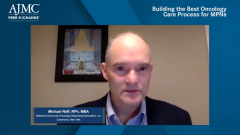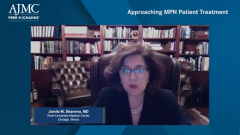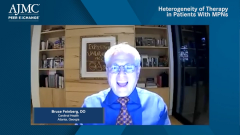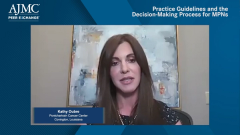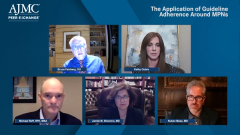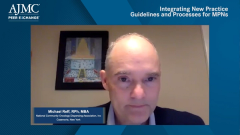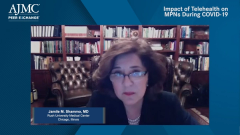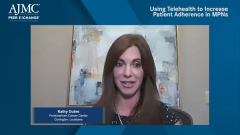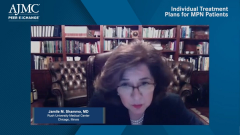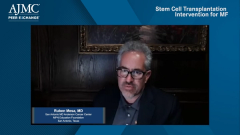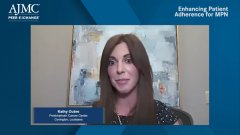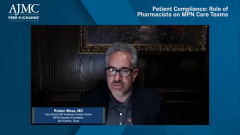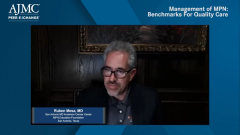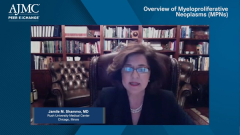
Integrating New Practice Guidelines and Processes for MPNs
Kathy Oubre and Michael Reff, RPh, MBA, reflect on reactions to new guidelines for managing MPNs and how practices are integrating the new process, while Ruben Mesa, MD, shares his experience.
Episodes in this series

Bruce Feinberg, DO: Kathy, when you talk about implementing a program like this, you have staff who have embraced it and went in whole-hog, and then you have doctors. Are the doctors embracing this? Are they innocent bystanders in the process? Where do they sit in that involvement?
Kathy Oubre: I hope they are not watching. Initially, they did not quite understand why we wanted to tackle this because they thought everything was going fine, and it was. But again, we have said this a few times: these patients are not seen. There are long lapses in between those visits, so it is possible for them to fall through the cracks. We pitched the idea to them, and there was no real harm in developing a safety net to ensure appropriate, better care for these patients. Once we got that buy-in, then every last one of the physicians had great input into the framework once we developed it. There was a bit of an initial question: “Why do we need to do this? Everything is fine.”
Michael Reff, RPh, MBA: I was going to add that part of this is dependent upon whether you are in the community, academia, IDN [integrated delivery network], or a health system setting. There is a lot going on. To have the whole medical team help raise the level of clinical outcomes for the collective patients at the practice, regardless of the setting, requires a culture of collaboration at the practice level. Of course, I think all the clinicians on this line would agree that there has been a tremendous amount of new developments in oncology over the last few years. Being able to keep up on anything and everything regarding every clinical trial is probably next to impossible, so having folks on a team step up and take a look at different areas of focus helps. It helps in a culture of continuous improvement.
Bruce Feinberg, DO: Kathy, in how many different disease entities do you have this kind of programmatic approach?
Kathy Oubre: Right now, there is just this one, but to segue off of Mike and then to answer your question, this was probably the first disease state that we have looked at. Within the last 18 months, we have tried to step up our game from a variety of perspectives: treatment education, survivorship care planning, and advanced care planning are all the different balls that we have in the air right now. This came from going to the NCODA [National Community Oncology Dispensing Association, Inc] meeting where it was being discussed and us saying, “This sounds cool. Let’s start with it.” We are then going to grow from there.
Bruce Feinberg, DO: Michael, how many other disease areas have you developed?
Michael Reff, RPh, MBA: Right now, we have around 55 to 60 individual positive quality interventions [PQIs], and they span many different disease states.
Bruce Feinberg, DO: Does each of those quality interventions represent 1 disease state?
Michael Reff, RPh, MBA: What I was going to say is, the short answer is no, but it does cover just about every therapeutic area within oncology at this point. Some of them are on disease states, and then some are focused more closely with individual products.
Bruce Feinberg, DO: How many of the features that comprise an individual program, how many of them mirror the IOM [Institute of Medicine] 13 steps that are part of the OCM [oncology care model]?
Michael Reff, RPh, MBA: The PQIs are part of a quality program that is part of accreditation to some of the pharmacy platforms, so it is quite fascinating to see how the positive quality interventions have been adapted and used as a source to hit some of the programmatic criteria for oncology care. It is quite interesting to see how it has been embedded and adapted across the oncology ecosystem.
Bruce Feinberg, DO: Kathy, that was what you were referencing: there is this dovetailing that has been taking place. You might not have all of the PQIs that Michael’s team has developed, but in a sense, you are getting there organically as you progress along this path.
Kathy Oubre: Yes. Oral adherence was something that we tackled several years ago after talking with Mike and his team. We already have a robust adherence program built for a lot of our patients, so we built this adherence program, and we dovetailed it into our patients with MPNs [myeloproliferative neoplasms]. Oftentimes, they might cancel an appointment, and you never know when you might see them again. It might be a hospital consult before you see them again, and that is what we want to avoid. We want to avoid those things, so if a patient misses an appointment, then we have those pop-ins built into our EMR [electronic medical record] and into our adherence programs such that we continue to monitor these patients or bug them until they reengage in their care.
Bruce Feinberg, DO: Both doctors put a hand up as you were talking, so you hit a nerve somewhere. Ruben, you go first, and then Jamile.
Ruben Mesa, MD: What Kathy has brought up more than once in terms of not falling through the cracks is key because these conditions, although chronic, can behave in unexpected manners. The biology is not linear. I sometimes have patients who are engineers, and when they come in, they have mapped out their blood cell counts. They say, “For the past 5 years, my counts have not changed more than this amount. My drugs has been the same. Could I come every 5 years?” The reality is that diseases are not linear. People are not machines.
The key is that they could change unexpectedly. We have patients for whom everything seems stable for 5 years, and there can then be an abrupt change. That is sometimes reflected in how they feel, but it is sometimes only reflected in their blood counts. I view the safety net both in terms of the minimum frequency of face-to-face or telemedicine visits that are helpful, as well as the minimum frequency of blood counts to evaluate their status for the disease. Then if things start to go off the rails, it is not at the extreme that it is found.
I find the sweet spot that I select is no more than every 2 to 3 months for blood counts and probably no more than every 6 months in terms of a face-to-face visit given the typical pattern with the disease. I then counsel them on unexpected things that could occur in between visits or blood counts that should prompt a connection with us to at least assess whatever has occurred in the context, through the lens, of knowing they have an MPN.
Transcript edited for clarity.
Newsletter
Stay ahead of policy, cost, and value—subscribe to AJMC for expert insights at the intersection of clinical care and health economics.


